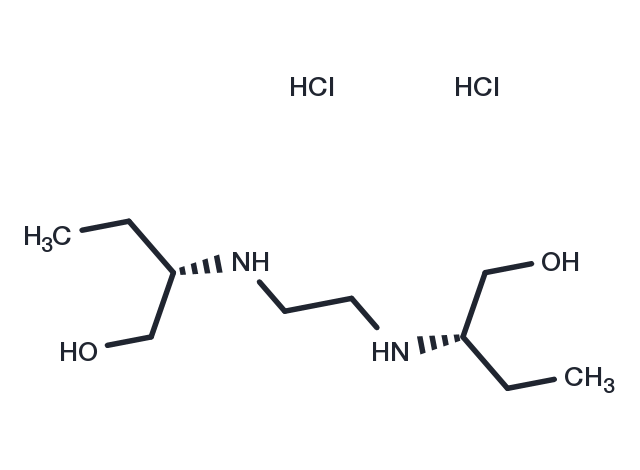Powder: -20°C for 3 years | In solvent: -80°C for 1 year


Ethambutol dihydrochloride (CL40881) is a bacteriostatic antimycobacterial agent, which obstructs the formation of cell wall by inhibiting arabinosyl transferases.

| Pack Size | Availability | Price/USD | Quantity |
|---|---|---|---|
| 1 g | In stock | $ 50.00 |



| Description | Ethambutol dihydrochloride (CL40881) is a bacteriostatic antimycobacterial agent, which obstructs the formation of cell wall by inhibiting arabinosyl transferases. |
| In vitro | In animal models, Ethambutol is administered orally at a dosage of 100 mg/kg. |
| In vivo | Ethambutol primarily targets the product of the embB gene, inducing mutations within the emb gene in drug-resistant strains of tuberculosis. In Mycobacterium smegmatis, Ethambutol affects arabinogalactan and lipoarabinomannan biosynthesis. |
| Synonyms | Ethambutol 2HCl, Emb dihydrochloride, CL40881 |
| Molecular Weight | 277.24 |
| Formula | C10H26Cl2N2O2 |
| CAS No. | 1070-11-7 |
Powder: -20°C for 3 years | In solvent: -80°C for 1 year
Ethanol: < 1 mg/mL (insoluble or slightly soluble)
DMSO: 52 mg/mL (187.6 mM)
H2O: 51 mg/mL (184 mM)
You can also refer to dose conversion for different animals. More
bottom
Please see Inhibitor Handling Instructions for more frequently ask questions. Topics include: how to prepare stock solutions, how to store products, and cautions on cell-based assays & animal experiments, etc.
Ethambutol dihydrochloride 1070-11-7 Microbiology/Virology Antibacterial Antibiotic Antifungal Ethambutol Dihydrochloride CL-40881 Ethambutol 2HCl Bacterial Ethambutol Emb Dihydrochloride Emb CL 40881 Inhibitor Emb dihydrochloride CL40881 inhibit inhibitor
